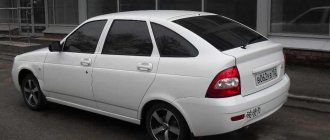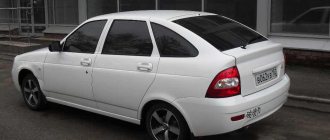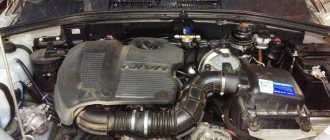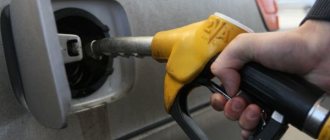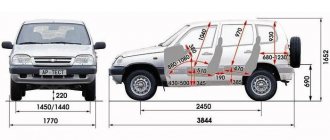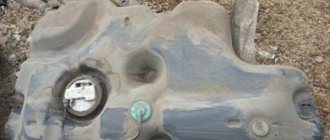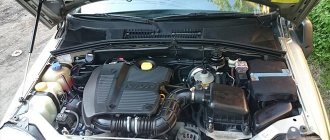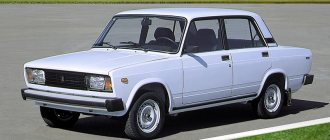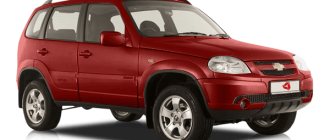Many car enthusiasts are confident that our automotive industry is in complete ruin and there are almost no companies left producing decent equipment. This is a misconception, and domestic designers can rarely surprise you with a worthy product. One of the results of fruitful work is the all-wheel drive Niva Chevrolet. The main feature thanks to which the car has conquered the domestic market is its increased cross-country ability. Chevrolet Niva has collected all the best features of previous models, supplemented by some new technologies.
This model is powered by a four-cylinder in-line petrol engine with a displacement of 1,700 cc. cm. The engine provides the car with power up to 80 hp. With. with a torque of 128 Nm.
Examples of savings in Moscow
For example, let's calculate two distances:
- From Red Square to the Moscow Ring Road and back in Moscow 50 km. How much gas does one save per month of such trips?
- From Moscow to Sochi - 1600 km. How much cheaper will it be to fill up with gas?
Savings after installing HBO
| Volume | Transfers | From Red Square to the Moscow Ring Road and back × month | From Moscow to Sochi and back | ||||
| Petrol | Gas | Saving | Petrol | Gas | Saving | ||
| 1.7 | Mechanics | 5 613 ₽ | 3 071 ₽ | 2 542 ₽ | 11 974 ₽ | 6 551 ₽ | 5 424 ₽ |
| Prices for a liter of gasoline and gas: 95 - 37.42 ₽, CIS - 18.61 ₽. |
If you spend more than an hour a day driving a Chevrolet Niva, then gas equipment will pay for itself in less than a year. Calculate your monthly and annual savings on your mileage using the savings calculator.
Chevrolet Niva - consumption according to the passport and real
Chevrolet Niva cars went on sale in 2002. The model has gained popularity largely due to its increased cross-country ability and unpretentiousness in terms of service. It is produced in a station wagon body, the configuration includes a number of additional equipment.
As practice shows, the fuel consumption of the Chevrolet Niva has become another reason why consumers from the CIS countries chose this model.
The relevance of this theory is confirmed by reviews from owners.
Of course, if it is necessary to reduce consumption costs, the Chevrolet Niva fuel consumption rate can be reduced, but this must be done provided there are objective reasons for this.
Specifications
According to the passport data, the technical characteristics of the Chevrolet Niva provide a cylinder volume of 1.7 liters. Thus, we can say that motor 1.
7 VAZ 2123 generates a power of 80 horsepower - this is a small figure when comparing the vehicle with competitive imported models.
On the one hand, this reserve is quite enough for SUVs of this class, but you shouldn’t count on maximum cross-country ability, regardless of weather conditions.
In modern models, the tank volume is 58 liters.
Naturally, the operating style, as well as a number of other factors, can influence how many kilometers the car can travel. The normal indicator can change either up or down.
Actual tank volume on the 14th model
As mentioned, the manufacturer claims that the volume of the 2114 tank is 43 liters (in some cases you can find a figure of 42.5 liters). And this figure is indeed very close to reality.
Tank volume VAZ 2114
At the same time, it is worth considering a number of facts that can significantly affect capacity:
- Errors in the manufacture of the tank.
- Time of year and temperature.
- Fuel system volume.
The first of these factors is usually insignificant. But, as practice shows, sometimes the difference in the volumes of two identical tanks can reach (as a result of low production accuracy) 2 liters. Thus, on some machines the total volume can reach 45 liters (which is extremely rare).
This should also include the difference in weather conditions. In cold weather, the fuel contracts, and in warm weather, it expands. This factor also affects how many liters the tank on a VAZ 2114 can hold (if we take into account the full volume of gasoline that can fit in hot summers and winter frosts, the difference can reach 1.5 liters).
Well, finally, you should remember that the fuel system itself also holds a certain amount of fuel. On average, when the tank is completely empty, up to 2 liters of gasoline can remain in it. As a result of this number of features, the amount of fuel contained in the tank may differ from that declared by the manufacturer, either more or less.
Gas tank VAZ 2114
It is also worth noting that if the vehicle is operated incorrectly and refueled with low-quality fuel, sediment can accumulate at the bottom of the tank, which over time can (albeit insignificantly) reduce its volume. In order to avoid such a situation, the tank should be inspected every few years.
Recommended volumes and grades of fuel and lubricants VAZ 2121 Niva
The replacement operation will be the same for different modifications of the Niva car:
- VAZ 21214
- VAZ 21213
- VAZ 2121
- VAZ 2131
Our most popular engines are injection and carburetor engines, with a volume of 1.7 and 1.6 liters. The replacement process on these engines, as well as other modifications, will be the same.
The rest should be written down in a notepad, which is stored in the glove compartment of the cabin.
And it doesn’t matter that you are not going to do the car’s maintenance yourself, the specialists at the service station may also not know the refueling volumes of your car
Replacing lubricant in machine engines is a simple procedure that you can perform yourself, without the help of specialists. The main thing in this matter is to know what kind of oil and where to fill it.
If we talk about the VAZ 4x4 2121 Niva, then the engine should contain approximately 3.75 liters of oil product. Moreover, you need to fill in one brand of oil; different types cannot be mixed. Otherwise, the entire proportion will be ruined.
When mixing a mineral and a synthetic sample, the result will be a substance of low quality. It forms pieces that are not acceptable for the normal operation of the unit.
Replacing lubricating fluids is provided not only for the engine, but also for other components of the VAZ 4×4 2121 Niva. Places, filling volumes, names of oils are given in the table.
The number of these elements in each vehicle may vary
In addition, it is important to have a clear understanding of the location, types, engine and transmission oil used, types of lubricants and fluids
- After all, Chevrolet Niva filling tanks must be filled taking into account the plant’s recommendations so that all systems can fully operate.
- Video
In this article we will talk about how to change the oil in the gearbox, transfer case and axles of a Chevrolet Niva. The use of high-quality lubricants for vehicles plays an important role in the operation of any car.
The most common process for proper vehicle operation is the oil change process.
It is possible to change the oil yourself, without resorting to the help of auto service employees, while significantly saving money.
06.11.2017
The Chevrolet Niva has excellent technical equipment. The interior of the car is quite spacious, and it is easy to operate. Cars with a 5-speed manual transmission, which has a 3-shaft design, are widely used.
The gearbox of this vehicle is characterized by a complex structure, as a result of which its repair can cause certain difficulties.
The transmission system includes a transfer case, the function of which is that it affects the magnitude of the moment of force.
Half full or half empty?
Tank placement is a challenging task for engineers. After all, you have to take into account the load on the car, which, when refueling under a traffic jam, can fall on one side. We have to somehow divide the tank, turning it into a kind of butterfly. Well, or position it so that even when fully refueled, other devices compensate for the load on one of the sides. When choosing the location of the tank, the risk of damage in a collision is also taken into account.
The capacity of the tank is a relative value; it is impossible to fill it all the way; there will be some air left in it. When the car rolls, fuel can flow from side to side, and this is fraught with a dangerous situation. We all know from the theoretical driving school course which tanker is more prone to capsizing: one filled to the top or half empty. A significant mass of fuel, moving inside the tank, can also upset the balance of the machine. How do you deal with this? Partitions are made inside the tank to prevent overflow; their dimensions and location are carefully calculated.
Any tank is equipped with a ventilation system. In hot weather, fuel tends to evaporate, and the increased vapor pressure can even rupture the tank. And when gasoline or diesel fuel runs out, the pressure in the container drops - it can flatten. The ventilation system not only prevents this, but also traps fuel vapors, preventing them from being released into the atmosphere. A special valve prevents fuel from spilling when the car rolls over or rolls over.
As a rule, modern tanks also have an electric fuel pump module built into them.
It is important to remember: pumps for modern car power systems do not like to run “dry”, as a result they quickly fail. Therefore, do not allow the fuel to run out completely, try to refuel as soon as the reserve light comes on, because the fuel pump is not cheap, and even the cost of replacing it...
Car tank
Average fuel consumption per 100 km is 8-9 liters of AI-95, Premium-95 or AI-92 gasoline. The location of the tank is in the rear seat area. The upper part of this filling tank with a small hatch is equipped with a fuel pump.
For a more detailed analysis of the situation with the capacity of the gas tank, let's analyze the design of this fuel storage tank.
The tank is made of high-strength steel by stamping. The structure of the tank is simple but reliable - it consists of 2 parts that are connected to each other by welding.
To prevent the tank from deforming due to the influence of changes in pressure, valves are installed in the filler plug. The filling pipe and gravity valve parts are made of plastic in the form of a single block.
These elements are connected to the fuel tank using three rubber hoses, each of which has a different diameter. The electronic submersible type fuel pump installation is located inside the tank.
Using the sensor, the driver determines the amount of fuel liquid that the volume of the Chevrolet Niva tank can hold. This option allows the driver to control the remaining gasoline and reduces the likelihood that the car will be left with an empty tank without the knowledge of its owner.
https://youtube.com/watch?v=1YUVm6OX2iw
Is it possible to accurately determine the remaining gasoline in the tank?
The volume of the Chevrolet Niva fuel tank at a single gas station can be filled to a level of 60 liters. But it is impossible to determine how much fuel is left in the tank when the red warning light comes on. This is explained by the structure of the tank, which has a stamping for the driveshaft.
Due to partial communication between the cavities of the fuel tank, fuel in an amount of 5 to 7 liters may remain unclaimed. The driver may not count on this gasoline, since such fuel is “dead weight.”
Technical characteristics of the Chevrolet Niva
The main feature that defines the concept of the brand is the presence of all-wheel drive. High cross-country ability and maneuverability, the ability to lock the differential, and compact size are considered additional advantages from the manufacturer AvtoVAZ. The transfer case is equipped with a low range of gears, which is considered the main assistant for towing and off-road driving.
Chevrolet Niva is equipped with increased heat resistance and sensitive grip, giving additional confidence on the roads. Performance characteristics depend on the configuration and year when the SUV was produced. Common features are collected in a table.
Chevy Niva characteristics:
| Name | Description |
| Dimensions | from 4048 x 1770 x 1652 to 4056 x 1800 x 1690 mm |
| Total weight | from 1400 to 1520 kg |
| Volumes | From 1.6 |
| Ground clearance (ground clearance) | From 200 mm |
| Transmission | Permanent drive, 2-speed transfer case |
| Brakes | Front: disc, rear: drum. |
| Suspension | Front: 2 wishbones, rear: dependent. |
| Engine characteristics | Gasoline, with 4 cylinders, distributed fuel injection. Power is 80 hp and torque reaches 127.4 Nm. The maximum speed reaches 140 km/h. |
| Radial tires | 205/75R15, 205/70R15, 15/65R16 |
| Fuel | The gas tank volume is 58 l |
| Fuel consumption (combined) | 10.2 l/100 km |
| Oil consumption | About 0.2 liters per 1000 kilometers. |
The vehicle has 5 seats equipped with seat belts. Load capacity, depending on modification, is about 420 kg. The trunk has a volume of 320 liters. If you fold the rear seats, you get an overall compartment of ˗ 650 liters.
Fuel consumption and distance traveled
There is some information about the fact that the Duster tank actually has a volume of 50 liters and 60. On one of the owner forums there was information that on the 4×4 version of the car it is perfectly possible to fill the tank with 60 liters, this difference depends on the intensity of fuel pouring into the tank when fuel is poured, a traffic jam is quickly created, and therefore manufacturers indicate in the documentation the tank volume is 50 liters. If the filling speed is maintained at 40 ml/s, then you can win 10 liters. Every car owner understands that the duration of the route without additional refueling directly depends on the volume of the fuel tank, as well as on the fuel consumption of the engine in liters. Duster has several types of configuration, and in each of them this same distance will be different.
Note that the mileage traveled by the Renault Duster was calculated by auto mechanics based on fuel consumption while driving on the highway at a speed of 110 km/h
In addition to the gas tank, Renault Duster has several other important points that you need to pay attention to
A trip to the mother-in-law - how much gas does Shevik consume?
Aloha to all fans of the Chevrolet Niva. Yesterday we came on a short cruise - we drove 300 kilometers one way to my mother-in-law. Here I would like to describe my feelings from the trip.
First, we filled up with 92 gasoline for 700 rubles (the price tag here is 31 rubles in Kirov). Drive to Rudnichny 290 km one way.
The first 90 kilometers the road is good, but the trucks constantly go non-stop, plus there are permanent settlements where the gays really like to stand.
I don’t have a radar detector yet, so I had to cut the first hundred at 70-80 km/h. I drove mostly in 4th gear, approximately 2900 rpm.
However, as soon as I left Belaya Kholunitsa, where the road was empty, I immediately drowned the kid there, since my tires were not studded, and there the road was powdery (late February), I didn’t drive too hard, I was driving at a cruising speed of 90 km/h in 5th gear.
The number of revolutions became 2400 and here it is - the perfect balance of speed and efficiency. So if it seems to you that the Chevrolet Niva consumes a lot of gasoline, perhaps you should drive either slower or faster? Personally, 90 km/h is enough for me, the ride is very comfortable, and it really saves gas. I think 8 liters per hundred square meters maximum.
Having reached Kirs (240 km from Kirov), it was decided to top up the little guy with gasoline, because there was still a lot left. And oppa - there is no 92 gasoline. I had to add 6 liters of 95 to get 45 km. And then I felt the difference - the car drove, even uphill in fourth gear - it pulled without problems.
So if the instructions recommend pouring 95, pour it, the only thing is that it may be of low quality. I used Lukoil, everyone praises it.
For 45 kilometers I just flew like on wings, in 5th gear the speed was 90 km/h, I didn’t even shift on hills)) However, as people say, it’s hard to start at 95 in the cold, when we arrived (north after all), it was frosty minus 28.
However, the next day they promised warming, we got ready to go back for lunch - the temperature was already -15, and the sun was warming up at the end of February. So even on 95 gasoline they started.
We drove to a local gas station and filled up with 800 rubles worth of 92nd.
Read my blog, subscribe, spring and summer are coming - there will be a lot of travel, which means there will be photo reports on fishing and searching with a metal detector. It will be interesting))
What is the volume of the fuel tank in the Niva Chevrolet?
Chevrolet Niva is a serial all-wheel drive off-road vehicle produced by the Volzhsky Automobile Plant. Drive to all four wheels is permanent, all-wheel drive. The Niva is equipped with a two-speed transfer gearbox and a locking differential, allowing it to overcome inclines of up to 35 degrees.
The Chevrolet also performs well off-road and is able to navigate difficult areas in any weather.
The new brainchild of AvtoVAZ Chevrolet Niva specialists embodies the advantages and advantages of the previous model, supported by the introduction of new production technologies.
Modification of Niva Chevrolet
Since the end of 2006, Chevrolet Niva FAM1 cars began to roll off the AvtoVAZ assembly line. The car had an Opel engine with a volume of 1800 cm³ and allowed it to develop a power of 122 hp. This Niva model was equipped with a 5-speed manual transmission, a new transfer case, made in the same unit with the gearbox. This model had a richer package:
- ABS system, providing an increased degree of safety when braking;
- increased diameter vacuum brake booster (10 inches);
- drive joint shafts;
- Interior air conditioning, providing additional comfort for passengers and driver;
- two front airbags, which significantly increased the car’s safety performance;
- front seats adjustable in three planes;
- Pre-action seat belt tensioners.
Niva Chevrolet fuel tank
The Chevrolet Niva is made in a two-volume body, while having sufficient space for passengers, but is somewhat constrained by the size of the luggage compartment. In order to save space in the car body, the tank is located under the bottom and has a rather complex bent structure with pockets and unconnected cavities. In view of this, peculiarities arise with the determination of fuel reserve.
Volume of the tank
The rated volume of the Chevrolet Niva fuel tank is 58 liters. When a certain minimum level of gasoline is reached, the light begins to flash, after which it remains on continuously, which indicates a low fuel reserve in the tank.
It was experimentally established that the lamp lights up at 12 - 15 liters, since some experts claim that the Niva fuel tank has a large dead reserve. At the same time, 42-44 liters of gasoline were added to the gas station cutoff. That is, the conclusion suggests itself that the volume of the car’s tank reaches 61 liters.
To get an answer, you need to consider the following nuances and features:
- The fuel gauge on the dashboard is unable to accurately indicate the amount of gasoline because it is not a calibrated measuring device.
- The readings are significantly affected by the location of the car relative to the horizontal plane.
- Accordingly, the ambient temperature has some influence, contributing to a change in such a quantity as the volume of liquid.
Features of fuel tank volume
Therefore, the light on the Chevrolet panel lights up at different levels of fuel in the tank. When filling to the cut-off point, the filler neck may be filled, which increases the volume of gasoline poured. In this case, the quantity also depends on the filling speed of the filling column.
The Niva fuel tank has a specific bottom geometry; it is partially divided in half by stamping made for the driveshaft channel.
Therefore, the tank cavities are partially connected, which leads to the formation of a dead stock of 5-7 liters.
It is also necessary to take into account that the fuel sensor is installed on the right side of the tank in the same plane as the fuel take-off pipe and the filling neck; accordingly, the presence or absence of dead stock in the left cavity is not always taken into account.
If the car has a small amount of fuel and was moving on a rough road before refueling, then the amount of reserve in the left compartment may be minimal, while refueling at the cut-off point will reach up to 60 liters.
It is especially important to remember that in hot weather it is undesirable to fill the fuel tank to the limit, since it must contain a small reserve of volume to compensate for expansion and fuel vapors
Features of tank refilling
Sometimes the driver notes that filling a full fuel tank at a gas station is measured with a gun cut-off device to the number 42-44. Could it be that the Chevrolet Niva gas tank holds 61 liters of fuel?
To clarify this issue, consider the features of the car tank design:
- the fuel gauge device installed on the instrument panel should not indicate the exact volume of the fuel tank for each individual vehicle, since it is not a calibration device;
- when taking readings, it is important how the machine is positioned relative to the horizon;
- minor deviations may be present due to weather conditions and air temperature.
What is the tank volume in a Chevrolet Niva
The Chevrolet Niva is positioned on the Russian market as an all-terrain vehicle, which is produced at the Volzhsky Automobile Plant. The car is distinguished by the presence of permanent all-wheel drive. This is achieved by the presence of a two-stage transfer case and a locking differential. As a result, the car can overcome obstacles with an approach angle of up to 35 degrees.
In addition, the car is distinguished by improved cross-country ability, allowing it to overcome any off-road areas and withstand all weather conditions.
The car is based on the Niva 2121, which gained popularity in the former USSR.
When developing the new model, all structural components that had proven themselves in the previous model were adopted, and supplemented with new technologies.
Niva Chevrolet modifications
The cars are equipped with a gasoline engine with in-line cylinders. The working volume is 1700 cm3. The engine develops power up to 80 hp. or 59 kW. In this case, the torque is 128 Nm.
Chevrolet Niva has been produced since 2006 and during this time several modifications have been created. In top versions, a 1.8-liter Opel engine is installed, the power of which is increased to 122 horsepower. A 5-speed manual gearbox was combined with a transfer case. In addition, the following functions were built into the car:
- ABS system to achieve better braking results
- increased vacuum brake booster
- drive drive shafts
- air conditioning, airbags and other features that provide additional driving comfort.
- possibility of adjusting the seats in three directions
- seat belt pretensioners.
The body of the Chevrolet Niva is quite voluminous, providing comfortable seating for passengers. But at the same time, the size of the luggage compartment is not large. In order to save space inside the body, the fuel tank is located under the bottom.
To give it additional strength, a special bent design with pockets and additional non-communicating planes is used.
This design provides good performance properties of the vehicle, but there are problems with the distribution of fuel reserves.
In the Niva Chevrolet, the tank volume is 58 liters. The fuel in the tank is monitored using special sensors. A low reserve is indicated by a lamp on the instrument panel.
Usually the light comes on when there are 10-12 liters left in the gas tank. It must be remembered that due to the design, a lot is delayed in the dead zone.
If you refuel the car after the lamp is displayed, then the top-up to the cut-off can be 44-46 liters.
Depending on the type of gas station and the filling speed, the gas tank can hold up to 61 liters of fuel.
It is important to remember that the design of the tank has a specific feature. The lower part is divided into two cavities to make a channel for the driveshaft
Therefore, the cavities are separated, which leads to the formation of a dead stock of 5-7 liters. Therefore, when the warning lamp lights up, these features should be taken into account.
Tank location
As with any car, the fuel system of a Formula One car starts with the fuel tank. Since it is a storage tank for flammable and explosive gasoline, and plus is located in close proximity to the pilot, measures to ensure its tightness in any emergency situations are comparable, and maybe even higher, than those used in the aerospace industry. The fuel tank is located at the center of mass of the F1. This arrangement is due to the change in its mass during the race. If the tank were located, for example, at the rear or on the side, then as the mass of fuel decreased, the weight distribution along the axes of the car would change. Accordingly, this would completely disrupt the machine's setup.
The tank is a fairly large part of the car, and therefore, with any change in the aerodynamics of the middle part of the car, it has to be completely redrawn and fit into the newly formed space.
The tank is located behind the back of the F1 pilot and, therefore, any damage to it is fraught with fire of racing fuel and fatal consequences for the person behind the wheel of the car. To prevent fuel breakdown and leakage, the tank is made soft and freely deformable. The strength elements of the monocoque running in the area where the tank is located are further strengthened to further protect such a dangerous element of a formula one car.
All fuel system hoses are equipped with solenoids, which, in the event of an accident associated with a ruptured line, cut off the fuel supply. The car is also necessarily equipped with a fire extinguishing system that can cope with a serious fire. By the way, the total weight of the fire extinguishing systems of a formula one car reaches 5-7 kg, which is not so little for it, when the struggle during the design is for every gram, but safety comes first!
Technical characteristics of the 1st generation Chevrolet Niva
The compact SUV Chevrolet Niva has been produced since 2002 at the facilities of the GM-AVTOVAZ joint venture in the city of Tolyatti. Throughout its existence, the car has remained virtually unchanged from a technical point of view. The model is based on the VAZ-2123 platform, which assumes the presence of an independent 2-link suspension at the front and a continuous axle at the rear.
Chevrolet Niva is a real SUV with “honest” all-wheel drive, which is implemented using a transfer case that distributes torque between the front and rear axles in a 50/50 ratio.
A lowering row, an interaxle locking mechanism and good body geometry significantly increase the vehicle’s capabilities in off-road conditions.
The car feels no less comfortable in a dense urban environment, where the compact dimensions of the body are a plus - 4048x1770x1652 mm.
Engine Chevrolet Niva 1.7 VAZ-2123
A 1.7-liter VAZ-2123 engine has been installed under the hood of the car since the start of production. The unit is a variation of the VAZ-21214 engine, adapted specifically for the Chevrolet Niva.
The engine is equipped with a cylinder block made of high-strength cast iron, a timing belt with an overhead camshaft and a chain drive (single-row chain with tensioner), a distributed injection system, a valve mechanism with hydraulic compensators (adjustment of valve clearances is not required).
The cylinder diameter is 82 mm, the piston stroke is 80 mm, the compression ratio is 9.3. The maximum output power of the engine does not exceed 80 hp, peak torque is 127.5 Nm (at 4000 rpm).
It was possible to increase the efficiency of the power unit through modernization carried out in 2015. As a result of the update, not only the fuel appetite decreased (by 2-4%), but also the amount of harmful emissions was reduced. This allowed the VAZ-2123 engine to comply with Euro-5 standards. Average fuel consumption of Chevrolet Niva 1.
7 is now 10.2 liters per 100 km (in the city - 13.2 liters, on the highway - 8.4 liters).
Characteristics of the 1.7 VAZ-2123 Chevrolet Niva engine:
Modification of Chevrolet Niva 1.8 122 hp
It is interesting that in the period 2006-2008, along with the VAZ engine, the Chevy Niva was equipped with a 1.8-liter Z18XE unit from Opel. It had more attractive technical parameters - power 122 hp.
and torque 167 Nm. Paired with the 1.8 engine was the same 5-speed manual transmission.
This version was not in great demand due to its high price, so it was subsequently withdrawn from the market.
Chevrolet News
Popular reviews from Chevrolet Niva 2015 owners with photos
11.25.2019Chevrolet Niva will be produced under a different brand
Updates are being prepared for the Chevrolet Niva. This is not about changing the platform or body, but about a face lift. The concept car shown in 2014 at the MIAS will most likely not see the light of day. The project was stopped after Chevrolet officially left the Russian market
more details
04/06/2018A new Chevrolet crossover will appear in Russia
The Russian representative office of Chevrolet announced the cost of a new product for our market - Chevrolet Traverse. The basic LE package is priced at 2 million 990 thousand rubles, although this package will have to wait up to four months after ordering.
more details
02/16/2018Sales of the updated Chevrolet Tahoe have started
Sales of the updated Chevrolet Tahoe have begun in Russia. In the minimum configuration, the car was valued at 3,450 tr., the maximum cost is 4,650 tr.
more details
02/15/2016GM-AVTOVAZ began production of a limited batch of Chevrolet NIVA
The automaker GM-AVTOVAZ launched a limited batch of Chevrolet NIVA in camouflage livery.
more details
03/19/2015Opel will leave the Russian market at the end of the year
Against the backdrop of falling demand for cars, General Motors announced the withdrawal of the Opel brand from the Russian market, as well as all mass models of the Chevrolet brand, the main reason being the low level of localization of production and the depreciation of the ruble. At the same time, the concern intends to maintain the sale of premium cars of the Cadillac and Chevrolet brands.
more details
08/15/2014 Not MIAS will present the new generation Chevrolet NIVA.
On August 27, at the Moscow International Motor Show, the GM-AVTOVAZ JV will present the new generation Chevrolet NIVA concept
more details
01/27/2014Licensing agreement for installation of PSA EC8 engine was signed
A license agreement was signed between the GM-AVTOVAZ JV and Peugeot Citroën Automobiles, granting the joint venture the right to install the PSA Peugeot Citroën EC8 1.8 liter, 135 hp, 170 Nm petrol engine in new generation Chevrolet NIVA cars.
more details
01/09/2014Chevy Niva increased in price by 10 thousand rubles
From January 1, prices for the Chevrolet Niva SUV have increased. All configurations of the model have increased in price, by 10 thousand rubles at once.
more details
12/23/2013Chevrolet Trailblazer fell in price by 155,000 rubles
The Russian representative office of Chevrolet has rewritten the price tags for the new Trailblazer SUV. As a result, all trim levels of the SUV have fallen in price by 155,000 rubles, which should increase the car’s popularity in the Russian market.
more details
Features of the gas tank
The Chevrolet Niva gas tank model has the General Motors factory part number 212301101011000. Like other fuel tanks for middle-class cars and a similar price category, it is made of welded steel sheets.
Steel as a material for a gas tank has its pros and cons. Benefits include:
- sufficient strength;
- high maintainability with minor damage;
- safety for the driver and passengers of the car, as well as for others.
However, a steel gas tank also has its disadvantages. It was they who influenced the fact that many modern models began to be equipped with plastic tanks. The General Motors steel tank body has the following disadvantages:
- If severely damaged, it cannot be repaired. A large dent, hole or split cannot be repaired, so you have to replace the part.
- Any steel sooner or later oxidizes, which means rust forms inside the container. Its entry into the vehicle's fuel system is not permissible. Therefore, steel gas tanks must be periodically cleaned of rust, suspended matter and other foreign matter.
A special feature of the Chevrolet Niva gas tank is its shape. It is located at the bottom of the car and has a stamping in the body for the driveshaft channel, which divides the gas tank into 2 reservoirs with partial communication with each other. Due to this feature, the fuel tank has a non-consumable reserve of 5-6 liters, which cannot be drained or used for its intended purpose, since they do not enter the fuel supply line.
Attention. The dead supply of gasoline remaining in the Chevrolet Niva gas tank is an unpleasant, but not particularly annoying problem for the model
Features of tank refilling
A gas tank capacity of 58 liters does not mean that you cannot fill up more gasoline at the gas station. On the one hand, the Niva tank has a non-consumable supply of fuel, on the other hand, the user manual indicates the direct capacity of the gas tank without taking into account the capacity of other elements of the fuel system. For example, the fuel neck can hold several liters of gasoline, and the fuel supply line has a similar capacity.
Therefore, it is believed that the total volume of the Chevrolet Niva fuel tank together with fuel lines can reach 62-64 liters of gasoline. Filling with gasoline under the filler neck does not pose any danger to the vehicle, unlike filling with gas fuel. If the gas tank is filled to capacity, the fuel hose nozzle will automatically stop supplying fuel.
Is it possible to determine the remaining fuel in the tank?
The Niva's low fuel level indicator usually lights up when there are approximately 10-15 liters of fuel left in the gas tank. Such a large spread between the values is due to several factors:
- The fuel level sensor (fuel meter) is not a calibrated device and cannot give accurate readings;
- due to the characteristics of the gas tank and the separation of the internal tanks, the measurement accuracy is impaired - the sensor is located in the right half of the tank, so it cannot measure the level of unconsumable gasoline reserves in the left half;
- The readings may be affected by the location of the vehicle on uneven surfaces;
- Also, the measurement of the fuel level may be slightly affected by the ambient temperature.
For these reasons, it is not possible to determine the exact level of gasoline remaining in the tank. The design features of the car and the insufficient accuracy of the fuel level sensor are the reason for the rather large scatter in the numbers.
After the low fuel level indicator light on the instrument panel lights up, it is quite possible to fill the car with 42-45 liters of gasoline.
Important! In case of overflow, the gas supply to the gas tank will be automatically switched off.
Gas tank characteristics
All Chevrolet Niva, regardless of generation and year of manufacture, are equipped with tanks of the same capacity and shape. The gas tank is made of sheet steel connected by welding. This material has its positive and negative qualities.
Advantages of a steel tank:
- High strength.
- Possibility of repair for minor damage.
- Safety.
There are only two disadvantages to the Chevrolet Niva tank:
- A gas tank cannot be repaired if it has severe dents or large holes.
- Rust forms inside the container, which must not enter the fuel system. Therefore, the tank needs periodic cleaning.
It has a driveshaft stamping that divides the gas tank into two partially communicating tanks. As a result, a remainder of 5-6 liters of gasoline is formed, which cannot be used.
The volume of the gas tank is 58 liters. This is enough to travel 400-600 kilometers on one gas station.
The part number is GENERAL MOTORS 212301101011000, but more often you can find gas tanks manufactured by AvtoVAZ. With acceptable quality, they cost from 8,000 rubles.
Can the tank hold more gasoline?
The capacity of the gas tank is indicated by the manufacturer without taking into account the possibility of filling fuel under the neck. Therefore, if desired, it can hold up to 63 liters . To do this, after shutting off, you need to lift the gun above the filler neck and continue refueling. The main thing is to do this in such a way as not to spill gasoline.
Unlike gas, filling up with liquid fuel is not fraught with danger. When heated, gasoline almost does not expand, and excess pressure is compensated through a vapor removal tube connected to the adsorber.
Video about the problem of the Chevy Niva gas tank
Source: https://nivaexpert.ru/xarakteristiki/vmestimost-baka-niva-shevrole/
Fuel tank capacity NIVA Chevrolet
Many car enthusiasts claim that the domestic automobile industry is in complete ruin and there are no worthy companies producing normal cars.
However, this is a complete misconception and our engineers, albeit infrequently, can produce products worthy of attention.
One of these is the NIVA Chevrolet all-wheel drive SUV from the VAZ automobile plant, which is in mass production.
Available modifications
In 2006, AvtoVAZ launched into mass production a new generation of NIVA Chevrolet, which used a more powerful power unit from Opel, in tandem with which the engineers decided to install a five-speed transfer-type manual transmission. This combination made it possible to significantly increase the power and dynamic characteristics of the SUV.
The electronic equipment of the car has also undergone significant changes. The vehicle has become more modern, comfortable and safe. The brake system is equipped with an anti-lock braking system, and the discs are equipped with ten-inch vacuum brake boosters.
To increase the reliability of protection and safety of life of the driver and front passenger, the developers equipped the SUV with two modern airbags. An active air conditioning system has been installed in the car interior, providing an optimal interior microclimate.
A pleasant surprise was the presence in the updated NIVA Chevrolet line of passenger seats with pneumatic drive, which allows you to adjust the level of inclination and height, which significantly increases the level of comfort.
The SUV leaves the assembly line in a two-volume body, the characteristic feature of which is a slightly reduced interior space in favor of the luggage compartment. To increase the efficiency of using usable space, the fuel tank was located under the bottom of the car, and was also made in a form with a very complex design, which has a certain impact on the gasoline supply.
Gas tank characteristics
According to the technical data sheet of the car, the SUV is equipped with a gas tank designed for 58 liters of fuel, and if the supply of fuel decreases, the system will notify the driver using a special indicator located next to the dashboard.
However, it should be noted that due to the design of the fuel tank and its complex shape, a dead reserve of gasoline of about 7 liters is formed in it. When the light flashes, indicating the need to replenish the fuel supply. This usually happens when there are about 10 liters of gasoline left in the tank.
When refueling, the driver can add about 44 liters, which leads to the conclusion that the actual volume of the gas tank is more than 60 liters. However, it is also necessary to understand the fact that it is impossible to give an unambiguous answer to the question about the volume of the fuel tank due to certain explainable reasons.
Ventilation
One of the important systems is ventilation. The fact is that the pressure in the tank must always be maintained equal to atmospheric pressure, and ventilation is responsible for this. Modern machines are equipped with a closed tank ventilation system, which prevents a drop or increase in pressure inside it. If the pressure inside the container decreases, it may become deformed, and an increase in pressure may generally tear the tank into pieces. Considering that there is fuel inside, a lot of attention is paid to implementing an effective ventilation system.
On topic: The most important secrets of moonstone
When fuel leaves the tank, the pressure in it drops, resulting in a vacuum. Thanks to the ventilation system, this effect is eliminated: a safety valve allows air inside. This valve is located at the neck cap and can only allow air to flow in one direction.
When refueling, excess air enters the tank, which causes the formation of gasoline vapors. These excesses are displaced by the ventilation system through a special pipeline. Also, gasoline vapors can form at elevated temperatures, which also leads to an increase in pressure. And only the ventilation system saves the tank from completely breaking into pieces.
Vehicle characteristics
In 2002, a significant event took place in the domestic automotive market. The Chevrolet Niva SUV, manufactured jointly by AvtoVAZ and General Motors, has gone on sale. Russian car enthusiasts have long been expecting the result of this cooperation. And their expectations were completely justified. Comfortable and convenient movement is the first of the advantages that the newcomer was generously endowed with. Thanks to these indicators, driving along municipal streets, standing in traffic jams, negotiating hundreds of branching country roads on the way to the dacha is not only easy, but also pleasant. This car model is quite maneuverable.
This SUV is comfortable to travel alone or with your family. The salon is designed for a long stay. On Russian roads, the jeep has no difficulty in moving and clearly fulfills its mission. This fact alone makes the vehicle a favorite of car dealerships. Let's analyze the volume of the tank and the consumption of the Niva Chevrolet.
This SUV is comfortable to travel alone or with your family. The salon is designed for a long stay. On Russian roads, the jeep has no difficulty in moving and clearly fulfills its mission. This fact alone makes the vehicle a favorite of car dealerships. Let's analyze the volume of the tank and the consumption of the Niva Chevrolet.
Let's sum it up
Car enthusiasts are often interested in the question of the capacity of the tank designed to supply fuel to the vehicle.
In terms of fuel consumption, the Chevrolet Niva car showed its efficiency. It is beneficial to use it for family trips, which allows you to use such a vehicle every day.
When refueling your car, you can count on a larger volume of fuel than indicated in the manufacturer's operating manual.
The information presented in this article will help determine the volume of the Chevrolet Niva tank.
Available modifications
In 2006, AvtoVAZ launched into mass production a new generation of NIVA Chevrolet, which used a more powerful power unit from Opel, in tandem with which the engineers decided to install a five-speed transfer-type manual transmission. This combination made it possible to significantly increase the power and dynamic characteristics of the SUV.
The electronic equipment of the car has also undergone significant changes. The vehicle has become more modern, comfortable and safe. The brake system is equipped with an anti-lock braking system, and the discs are equipped with ten-inch vacuum brake boosters. To increase the reliability of protection and safety of life of the driver and front passenger, the developers equipped the SUV with two modern airbags. An active air conditioning system has been installed in the car interior, providing an optimal interior microclimate. A pleasant surprise was the presence in the updated NIVA Chevrolet line of passenger seats with pneumatic drive, which allows you to adjust the level of inclination and height, which significantly increases the level of comfort.
The SUV leaves the assembly line in a two-volume body, the characteristic feature of which is a slightly reduced interior space in favor of the luggage compartment. To increase the efficiency of using usable space, the fuel tank was located under the bottom of the car, and was also made in a form with a very complex design, which has a certain impact on the gasoline supply.
Car modification
Since 2006, the plant began producing the Niva Chevrolet FAM 1. The car received an engine with a capacity of 1,800 cubic meters. cm, which made it possible to develop power up to 122 hp. With. and a 5-speed gearbox. This car model is equipped with:
- ABS system;
- vacuum brake booster;
- air conditioning;
- two airbags;
- adjustable front seats.
Fuel tank volume - experiment
What is the actual volume of the fuel tank
your car. I tried to find out personally.
Refill tanks Niva Chevrolet
Appendix 4. Chevrolet Niva refueling volumes
- Repair manuals
- Repair manual for Chevrolet Niva 2002+.
- Appendix 4. Filling volumes
2x h16
| Fuel tank | 58,0 |
| Engine cooling system | 8,0 |
| Engine lubrication system | 3,75 |
| Gearbox housing | 1,6 |
| Transfer case housing | 0,79 |
| Front axle housing | 1,15 |
| Rear axle housing | 1.3 |
| Hydraulic brake system | 0,5 |
| Hydraulic shutdown system | 0,15 |
| clutch | |
| Windshield washer reservoir | 5,0 |
| Tailgate glass washer reservoir | 2,0 |
| Front shock absorber | 0,15 |
| Rear shock absorber | 0,215 |
| Power steering | 1,7 |
Repairing auto parts yourself is a responsible task that should be taken as seriously as possible. Sometimes a faulty spare part takes the driver by surprise, forcing him to spend a lot of time and money searching for a good service station, but there is an alternative solution to the problem; this requires a small amount of knowledge and a set of tools.
When repairing Appendix 4. Chevrolet Niva filling volumes, you need to be extremely careful and not neglect the little things. To get acquainted with the issue, car enthusiasts often use various Internet portals dedicated to auto parts. Some of them use narrowly focused forums.
But, as a rule, only generalized information is provided there, which is known initially. Where can you find a reliable source that offers really useful things? Our portal is open for this 24 hours a day. Online mode allows us to help clients at any time convenient for them.
Moreover, a mobile version has been developed that is available to everyone.
A detailed description of such a unit as Appendix 4. Chevrolet Niva filling volumes has a good structure with thematic headings. In addition, there is always the opportunity to familiarize yourself with the intricacies of installation.
There are often situations when a driver is confident in his abilities, but when he gets down to work, questions begin to arise. Thanks to our portal, such moments can be easily avoided. The site is a database that is updated regularly.
By using it as a support during repair work, the car enthusiast receives a serious advantage. Each of the articles has reliable support, tested in practice.
In addition to the repair manual, the owner of a personal car will be able to prevent a lot of breakdowns that occur due to the human factor, thanks to the information located on the site. Users are presented with a lot of useful recommendations for proper operation, which will help significantly extend the life of the unit and avoid many negative consequences.
Online support is an excellent and most convenient way to obtain the necessary information. Another significant plus is that articles are written for people. We understand that the reader will do everything with his own hands, and we try to make it as convenient and efficient as possible. Use the resource at any time of the day and find the answer to any question you may have regarding cars.
Download information from the page
Experiment
To determine the actual volume of the tank, we’ll go to a service station and consult with specialists. For the completeness and objectivity of the experiment, it is necessary to use a measuring container into which gasoline will be poured from a fully filled tank.
This procedure will allow you to determine how much fuel fits in the tank. During the experiment, it is clear that the actual volume of the Chevrolet Niva tank is larger than indicated in the data from the manufacturer.
This procedure will allow you to determine how much fuel fits in the tank. During the experiment, it is clear that the actual volume of the Chevrolet Niva tank is larger than indicated in the data from the manufacturer.
Reading the vehicle's operating manual
The technical specifications declared by the manufacturer indicate that the volume of the Chevrolet Niva tank is 58 liters. If there is little gasoline left in the fuel tank, the driver will see a red light signal on the dashboard. Over time, if you do not refuel the car, the light will continue to glow.
As a rule, from the moment the light first lights up, you can expect that there is still about 12-15 liters of fuel in the gas tank.
